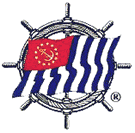Click
the answers that you think are correct — see how your
knowledge stacks up!
1. Carbon monoxide, a deadly gas, the effects of which mimic sea
sickness and intoxication, is:
2. A safety-conscious skipper never starts the engine on a gasoline-
powered boat before:
3. Before fueling a boat with a built-in fuel tank, you should:
4. If you are caught on the water in bad weather, your first step
should be to:
5. When docking your boat it is desirable to plan the
procedure in advance and:
6. The correct anchor for your boat will depend not only on the size
and type of your boat but on the:
7. When participating in water sports such as water skiing,
boardsailing, operating a personal watercraft, etc.it is important to:
8. To attract attention when you have an emergency in a small boat,
blow your whistle or horn, or:
9. You should have charts of the area where you are boating onboard to
help you determine where you are and:
10. The times and heights of tides are:
11. If a fire occurs when operating your PWC, stop the craft immediately
and:
12. Which of the following statements is TRUE?
13. Federal law prohibits:
14. Navigation Rules that apply to sailing vessels also apply to:
15. Federal regulations require that all recreational boats have:
16. A condition that could result in Coast Guard termination of the use
of your boat is:
17. If involved in a boating accident,federal regulations require that
the boat operator immediately file a report with the:
18. Navigation lights for both powerboats and sailing vessels under 65.6
feet include red and green sidelights and a white sternlight. However,
powerboats of that length also are required to have a:
19. At night, off your starboard side, you see a boat with a white light
over a red light. You take immediate precautions because
you are meeting a:
20. The purpose of The Navigation Rules is to:

